Exploring the World of Wooden Quarter Pipes in Surfing
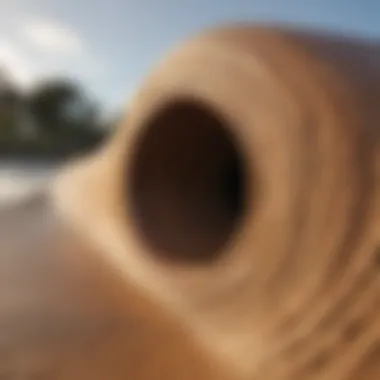
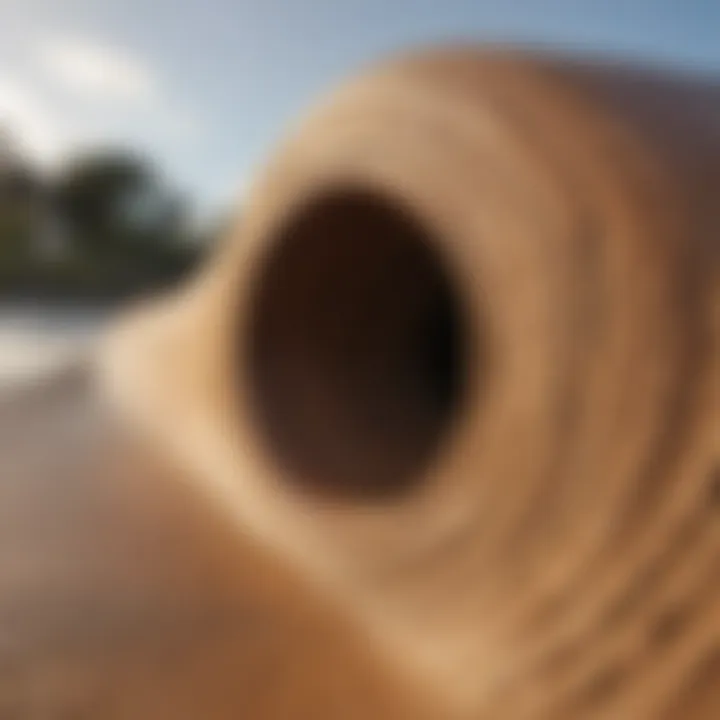
Intro
The wooden quarter pipe stands as a cornerstone in the realm of surfboarding, marrying skill and creativity on the waves. It not only challenges surfers to refine their techniques, but also serves as a hub for community interaction. Understanding the nuances behind these structures comes down to different layers—construction choices, material selection, and the experiences surfboarders collect with each ride. As we peel back the layers of the wooden quarter pipe, we will venture into its impact in surf culture and how these installations can elevate one’s surfing game.
Surfboarding Techniques
Beginner Tips for Mastering the Basics
If you’re just starting out, the wooden quarter pipe can seem like a daunting task. However, with the right approach, it can become a vital part of your surfing journey. Here are a few tips:
- Stay Low: Keeping your knees bent lowers your center of gravity, providing more stability.
- Commit to the Ride: Don't hesitate at the top. The more confident you are, the smoother your descent will be.
- Use Your Arms: Balancing is key. Extend your arms out to aid stability while you're moving along the pipe.
- Practice Regularly: Frequent exposure helps to build muscle memory. Just like riding a bike, the more you practice, the smoother you'll glide.
Remember, practice makes perfect, and falling is part of learning. The quarter pipe can be your best friend if you treat it right.
Advanced Techniques for Seasoned Surfers
Once you've gotten the hang of the basics, it's time to level up your skills. The wooden quarter pipe offers plenty of opportunities for seasoned surfers to push their limits. Here are a few advanced techniques:
- Carve and Slash: Engaging with the edge of your surfboard while gliding off the quarter pipe helps you gain momentum as you transition into a wave.
- Ollies and Grab Tricks: Incorporating ollies not only looks impressive but also adds style to your ride. Don't shy away from experimenting with grab tricks to highlight your uniqueness on the waves.
- Boosting Air: Engage your core and use your legs to pop off the lip. Be mindful of your landings, as they can greatly affect your next move.
Stepping into these advanced techniques requires patience and a willingness to fail. Embrace the process, and the rewards will follow.
Surfboard Equipment
Reviews of the Latest Surfboards on the Market
With an ever-evolving array of surfboards available, choosing the right one to complement your quarter pipe experience can be overwhelming. Recent entries to the market feature innovative designs that emphasize performance and durability:
- Channel Islands High Fiesta: Known for its versatility, it’s perfect for both carving and aerial maneuvers, adapting beautifully to the quarter pipe's curves.
- Firewire Longboard: For those who prefer stability in their ride, this longboard excels in smooth transitions and provides an unparalleled sense of control.
- Lost Surfboards RNF for Kids: Tailored for younger surfers, it embraces safety with a fun factor to onboard the next generation of wave riders.
Essential Gear for Every Surfboarder
Every surfer should have certain gear to enhance their experience with wooden quarter pipes. Here’s some must-have equipment:
- Wetsuit - Essential for comfort in various water temperatures.
- Leash - Keeps you tethered to your board, especially crucial in crowded waters.
- Wax - Helps maintain grip on your board, providing that much-needed confidence as you navigate tricky transitions.
- Safety Gear - Helmets and pads can mitigate risks, particularly during those ambitious maneuvers.
As you build your gear collection, remember that quality trumps quantity. Investing in superior equipment can change your surfing experience significantly.
"A quarter pipe is not just a structure; it’s a canvas for a surfer’s artistry and a community gathering space that fosters growth and creativity."
Embracing the wooden quarter pipe means more than simply riding. It’s about understanding your body’s mechanics, building connections within the surfing community, and pushing your limits. With careful consideration and dedication, you can integrate this incredible structure into your surfing practice and grow alongside it.
Preface to Wooden Quarter Pipes
The wooden quarter pipe stands as a symbolic figure within surfboarding culture, embodying not just a physical structure but a multifaceted element crucial for skill enhancement and community interaction. As surfers seek better ways to push their limits, the design and construction of these ramps have evolved. Exploring the wooden quarter pipe reveals insights into user experiences, considerations for safety, and the fine line between aesthetics and functionality.
Quarter pipes, often integrated into parks or personal backyards, provide a thrilling boost of adrenaline, allowing surfers to practice maneuvers that help improve their techniques. Yet, it goes beyond personal growth; these structures serve as communal hubs, drawing in fellow enthusiasts who share a passion for the waves. It only makes sense for surfers and instructors alike to understand their significance. They act as bridges—bringing together diverse individuals who find common ground in their love for surf culture.
With this framework in mind, we aim to dissect the wooden quarter pipe’s various dimensions, starting with the fundamental concept itself. Let’s dive into what quarter pipes represent in the surfing community.
The Concept of Quarter Pipes
At its core, a quarter pipe is a ramp that features a curved surface, allowing users to launch off and gain height for tricks and jumps. Often made of plywood and designed for durability, these structures can vary significantly in size, shape, and purpose. The geometry of a quarter pipe is not mere technicality; rather, it serves a critical role in delivering the right performance to the riders. The sustainment of speed, the balance of traction, and the style of dismount are all influenced by how well the pipe is constructed.
Interestingly, these ramps are utilized not only in surfboarding but also find relevance in skateboarding and BMX biking, showcasing their versatility. It’s fascinating how a piece of wood can carve out a unique experience. A surfer can master the art of slashing through one corner only to learn a new flip when launching off another. Each interaction shapes their style into something distinct.
Historical Context
The origins of the quarter pipe can be traced back to the early days of skateboarding, woven through the fabric of alternative sports culture. These structures emerged from the desire to mimic the natural inclines found in nature when skateparks started popping up in the mid-20th century. It wasn’t long before surfers, craving similar thrills on land, embraced these designs, resulting in a cross-pollination of techniques and styles across various boards.
In surf culture, the quarter pipe’s appeal lies in its ability to facilitate practice on land, simulating the dynamics of riding real waves. From the iconic designs of the 1990s, which often featured simple straight lines, to today’s more complex and customized versions, the quarter pipe has evolved alongside surfboarding. The modern surfer’s desire for innovation fuels changes in both design and function, reflecting trends in style, culture, and even environmental consciousness.
As the scene continues to transform, the essence of the quarter pipe remains a testament to human creativity and passion for adventure. Surfers no longer just look at these structures as simple ramps but as integral components of their journey toward mastering the ocean. Why just ride the waves when you can also conquer the air?
Design Elements of Wooden Quarter Pipes
Designing a wooden quarter pipe is more than just a craft; it’s a blend of art and engineering that caters to the unique needs of surfers. These features don’t just enhance functionality but also enrich the overall experience on the wave, making the design elements crucial to explore. Here we dive into the key components and customization options that can elevate any wooden quarter pipe.
Key Components
The foundation of a quality wooden quarter pipe rests on its key components, each playing a vital role in performance and safety.
Ramp Structure
The ramp structure is arguably the most prominent feature of a wooden quarter pipe. It’s what your skateboard or surfboard glides up and down, after all. A well-designed ramp typically has a smooth, flowing curve that allows for a gentle transition from horizontal to vertical. The design encourages smooth tricks while providing enough support to handle the weight of the rider.
One of the unique characteristics is the width of the ramp. Wider ramps allow for more flexibility in trick execution and generally offer greater stability. However, a wider structure may take up more space, which could be a disadvantage if you’re constrained by area. A well-angled ramp structure enhances performance, giving riders higher trajectories and smoother landings.
Height and Width Specifications
Height and width specifications are crucial determinants of how the quarter pipe is used. Generally, a height of around three to four feet is optimal for recreational surfing. But why is this so? A ramp that’s too low lacks the thrill, making it challenging to build speed, while one that’s too high can intimidate newcomers, potentially discouraging them from trying it.
Measuring about eight to ten feet in width, many surfers appreciate this specification as it allows room for maneuvering without being overly confined. It strikes the right balance between excitement and accessibility, making it appealing for both beginners and seasoned surfers.
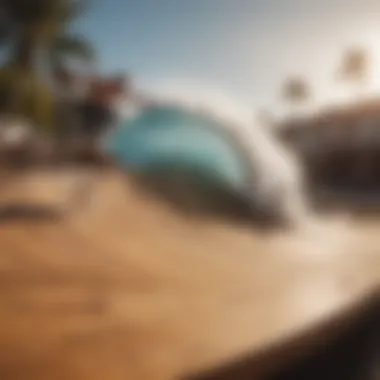

Materials Used
The choice of materials for construction can significantly affect everything from durability to aesthetics. Typically, plywood is the go-to choice due to its resilience and ease of use. For those who want a bit more longevity, marine-grade plywood is excellent, as it's resistant to the elements, ensuring a longer lifespan.
The downside? Sometimes, these materials can be pricier. However, the investment pays off when you see how a sturdy ramp can sustain heavy daily use without breaking down. Additionally, incorporating methods to treat the wood, such as sealing it to avoid moisture absorption, can enhance its lifespan further.
Customization Options
Numerous customization options allow for creativity and personalization in designing wooden quarter pipes. From finishing techniques to color, making these choices can transform a standard ramp into something unique.
Finishing Techniques
Finishing techniques are essential for protecting the wood and enhancing its appearance. A popular method is applying a polyurethane coat, giving it a glossy finish that resists scratches and moisture. This adds both durability and aesthetic appeal.
For those looking for a rustic touch, oil or wax finishes can highlight the natural grain of the wood. The downside? These might require more frequent reapplication compared to synthetic coatings, but many appreciate the beauty of a well-maintained, naturally finished surface.
Color and Design Choices
Customization also extends to colors and designs. Many boards can feel mundane, but adding colors or artistic designs can bring your ramp to life. Whether it's bright cheerful hues or intricate graphics, the choice reflects the personality of the owner, making the ramp not just a functional piece but a statement piece too. Although opting for more complex designs might increase initial time and costs, it could foster a sense of ownership among surfers. Tailoring the look can also enhance community interactions as fellow surfers unify in shared aesthetics, making it more appealing and inviting.
In summary, understanding the design elements of wooden quarter pipes allows for informed decisions when building or customizing one. This makes the experience not only more enjoyable but also more aligned with individual preferences and needs in the surfing community.
Construction Techniques
When it comes to crafting wooden quarter pipes, the manner in which they are constructed can greatly influence their performance, durability, and safety. Understanding construction techniques can be the difference between a great riding experience and safety hazards. This section emphasizes how various construction methods can impact the final product, touching on both DIY approaches and professional builds.
Do-It-Yourself Builds
Materials Needed
Creating your own wooden quarter pipe can be a rewarding challenge. Selecting the right materials is crucial. For most DIY enthusiasts, plywood remains a staple due to its cost-effectiveness and strength. Typically, sheets of 3/4 inch plywood are recommended, as they offer both flexibility and resilience without excessive weight.
Another material to consider is hardwood for areas that require higher durability. Maple and birch ply are particularly commended for their longevity under stress, though they can come with a steeper price tag.
The unique characteristic of plywood is its layered construction which provides stability and resistance to splitting under pressure. It’s a beneficial choice for DIY builds because it can be easily sourced from local hardware stores. However, a downside is that, if not treated properly, plywood can warp or delaminate when exposed to moisture.
Step-by-Step Guide
Once you’ve gathered your materials, having a clear step-by-step guide is essential for a successful build. The first step generally involves sketching out your design—this will map out the angles, height, and overall dimensions of the quarter pipe. The key characteristic of a step-by-step guide is the structured approach it provides, breaking down the construction process into manageable parts.
Commonly, you start by building the frame, ensuring it is robust by using 2x4s for support beams. From there, you would lay out the plywood sheets to form the ramp, securing it with screws. Each layer is carefully fitted and checked for alignment.
A benefit of having a detailed guide is that it lends efficiency to the construction process. However, one unique feature is that DIY builders often learn valuable skills in carpentry and problem-solving as they navigate challenges during the build. Yet, it's essential to remember that a lack of experience can lead to mistakes that might compromise safety.
Professional Construction
Contractor Insights
For those who prefer to pass the construction duties to professionals, understanding contractor insights can be incredibly valuable. Skilled contractors often bring experience and an understanding of local regulations. This choice can mean that you receive a well-constructed quarter pipe, but it also usually comes with a higher price tag.
An essential aspect of professional construction is craftsmanship. Contractors often use specialized tools and techniques that aren’t typically available for DIYers. However, it's crucial to research potential contractors, looking for reviews and examples of their past work to ensure quality.
Cost Analysis
The financial aspect of building a wooden quarter pipe cannot be ignored. Cost analysis involves considering both initial construction costs and future maintenance expenses. On average, professional builds can range significantly in price based on complexity and materials. While a DIY build might average around a few hundred dollars using lower-grade materials, professional construction could easily exceed a thousand dollars when opting for top-tier woods and craftsmanship.
One advantage of professional construction is the reduced risk of structural failure. That peace of mind is valuable for someone serious about their surfboarding practice, as it ensures that the quarter pipe will withstand rigorous use. Yet, it’s also important to weigh that against budget limitations to find a sustainable approach to construction.
"Choose the right materials and methods; they hold the key to a safe and enjoyable surfing experience."
Benefits of Wooden Quarter Pipes
Wooden quarter pipes stand as more than just a ramp for surfboarding enthusiasts; they symbolize progress in skills and community connection. When surfers engage with these structures, they not only sharpen their technique but also build a community around a shared passion. Their multifaceted benefits stretch far beyond the surface, influencing individual growth and collective experiences alike. Let's break down their significance in two main spheres: skill development and community engagement.
Skill Development
Improving Techniques
One of the standout benefits of wooden quarter pipes is their role in improving techniques. The structure encourages surfers to push their limits and refine their skills. The inclination of the ramp allows for practice in a controlled setting, where each glide can morph into a chance for mastery. The beauty of these ramps lies in their adaptability; they cater to both novices and seasoned surfers, making them an indispensable tool for progression.
Practicing on a wooden quarter pipe can transform awkward attempts at a trick into fluid motion. Surfers can focus on balancing their weight correctly and mastering their board's responsiveness. The gradual increase in difficulty while attempting various tricks fosters confidence. Eventually, this leads to more audacious moves in larger surf or more challenging environments.
However, a word of caution is worth mentioning. Getting too comfortable can become a double-edged sword. Surfers may inadvertently neglect the essentials of wave riding, which can hinder performance in the ocean. But, with mindfulness, the benefits truly outweigh this risk.
Learning New Tricks
Wooden quarter pipes act as an ideal stage for learning new tricks. The element of safety is paramount when testing new maneuvers. As the ramps provide more grip than their metal counterparts, surfers often find themselves with a secnd chance if a trick doesn't quite land right.
Highlighting the support they offer, these structures can significantly reduce the intimidation factor associated with trying something new. Surfers can trick a few times, learning from each stumble without the fear of severe mishaps. Moreover, the innate flex of wood provides a unique feel that can be both bouncy and grounded. This balance often allows for experimentation that evolves into comfort with numerous tricks across styles.
That being said, over-reliance on the quarter pipe for learning tricks may deter some surfers from pursuing ocean conditions. Practice in natural settings should also remain a priority but with the quarter pipe as a primary tool, this learning can happen faster.
Community Engagement
Creating Local Gathering Spots
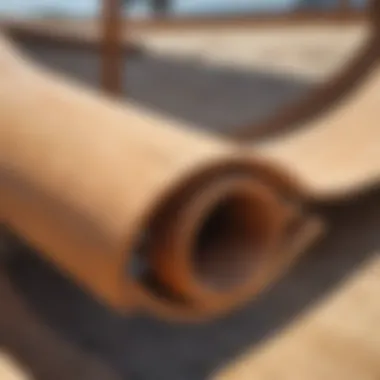
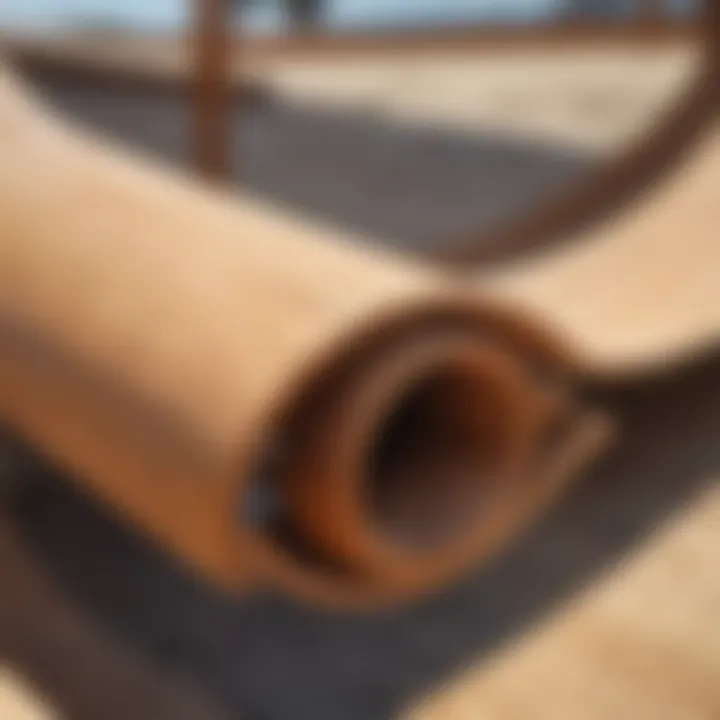
Wooden quarter pipes have a unique knack for fostering community engagement. They act as gathering spots for like-minded individuals seeking camaraderie and thrill. Local parks outfitted with these ramps become melting pots of creativity, bringing surfers of all skill levels together.
The social aspect of these ramps creates opportunities for individuals to connect and share tips and tricks. Newcomers receive guidance from experienced surfers, establishing a culture of support. Such gatherings embed a sense of belonging, an irreplaceable feeling for those within the surfing community.
Moreover, these gathering spots can sometimes turn into venues for community events or contests. This elevates the quarter pipe from a mere structure to a lively hub of interactions, which makes it particularly valuable. The downside? Well, noise levels can spike, and a lack of respect for space might arise amongst diverse groups. But, the positives generally outweigh this drawback, highlighting the potential of these setups significantly.
Fostering Supportive Networks
Wooden quarter pipes facilitate the formation of supportive networks, which are crucial for both personal and communal growth. Regular meet-ups and jam sessions create networks grounded in friendship and shared interest. The natural synergy and encouragement can lead to lifelong relationships among surfers.
When individuals come together to skate or surf, it becomes more than a physical activity; it transforms into a shared journey. Whether someone is struggling with self-doubt or facing obstacles in their path, the presence of a supportive group can be pivotal. Together, these participants uplift each other, share resources, and promote mutual growth.
However, there's also the challenge of managing diverse skill levels within these networks. It's essential to ensure that everyone feels included, regardless of their ability. Strong leadership within these communities can help guide members and foster inclusivity, reducing any elitist tendencies that may spring up.
Safety Considerations
Safety remains a focal point in the realm of sport, especially when it comes to activities like surfing that blend thrill with risk. In the case of wooden quarter pipes, understanding the potential hazards is crucial to ensuring a safe and enjoyable experience. Focusing on safety not only protects individuals from injuries but also enhances their overall performance by fostering a more confident riding environment. With this in mind, let's delve into the risks associated with quarter pipe usage and precautions one can take to mitigate them.
Understanding Risks
Common Injuries
Common injuries associated with riding quarter pipes can vary from simple scrapes to more severe accidents. The most frequently noted injuries include:
- Sprains and Strains: Often caused by abrupt falls or miscalculations during tricks, these injuries can sideline even the most skilled surfers.
- Fractures: Wrist and ankle fractures can occur if a rider falls incorrectly, landing awkwardly on a hard surface.
- Contusions: Bruises are particularly notorious, often resulting from mid-air tumbles or direct impacts with the ramp.
The key characteristic of these injuries is their unpredictability. They can affect anyone, from beginners to seasoned surfers, making knowledge essential. Understanding the dynamics of falling on a wooden quarter pipe allows riders to anticipate risks and learn how to fall safely. This emphasis on injury awareness is beneficial as it encourages riders to partake in safety training and consider their physical limits.
A unique feature of common injuries is their contextual nature; while they may often arise from lack of experience, they can equally stem from overconfidence. Riders who push their limits without adequate skill may find themselves at higher risk. The advantage of addressing this aspect in the article lies in spreading awareness, enabling enthusiasts to make informed decisions about training intensity and safety measures during practice sessions.
Impact Absorption Techniques
Impact absorption techniques supplement the safety of both the rider and their surroundings. Employing various methods can mitigate injuries effectively during falls. Key techniques include:
- Rolling Techniques: Learning how to roll upon landing can dissipate the force of a fall, reducing the chance of injury.
- Controlled Landing: Riders can practice stopping techniques that allow them to control their descent and avoid sudden impacts.
- Soft Landing Areas: Implementing padding or foam at the base of the quarter pipe could buffer a fall, providing that extra layer of security.
The primary characteristic of impact absorption techniques lies in their ability to distribute force, transforming potentially hazardous falls into manageable landings. This focus makes it a pivotal aspect of our discussion on safety in the article. By integrating impact absorption practices into training routines, riders can significantly lessen the threat of injury.
One unique advantage of emphasizing these techniques in the article is the empowerment it provides to riders. Being equipped with knowledge about how to cushion a fall can promote a more fearless approach, ultimately enhancing their skills and experience on the quarter pipe.
Protective Gear Recommendations
To enhance safety when using wooden quarter pipes, protective gear is both necessary and beneficial. Riders must seriously consider the following gear:
- Helmets: Always a must. A sturdy helmet can save a life.
- Wrist Guards: These are essential for preventing wrist injuries that can occur during rough crashes.
- Knee Pads: Protecting the knees from impact prevents injuries that can sideline a rider for considerable time.
- Elbow Pads: Like knee pads, these are important for shielding joints during falls.
In the end, safety gear isn’t just about looking cool—it's about getting back up on that board after a wipeout.
Wearing appropriate protective gear can greatly diminish the severity of injuries when things do go south. Such measures paired with understanding risks and impact absorption can create a robust safety culture among surfers using quarter pipes, ensuring a more enjoyable and sustained engagement with the sport.
Maintenance of Wooden Quarter Pipes
Caring for wooden quarter pipes isn't just an afterthought—it's a vital part of ensuring their longevity and optimal performance. When you put in the time and effort to maintain these structures, you set the stage for a safer and more enjoyable experience. This section dives into the two primary focuses of maintenance: regular care and upkeep. Such measures not only protect your investment but also enhance the overall riding experience.
Regular Care and Upkeep
When it comes to wooden quarter pipes, regular care is akin to regular check-ups for your health. Ignoring it can lead to bigger problems down the road. This section highlights how consistent maintenance practices can preserve the integrity and quality of the wood used in these ramps.
Preserving Wood Quality
Preserving wood quality is a critical aspect of maintenance. High-quality wood not only looks great but also performs better in the long run. Here, the focus lies on practices that help maintain the wood's structural integrity. One key characteristic of preserving wood quality is applying protective finishes. These finishes shield the wood from moisture and UV rays, prolonging its lifespan significantly.
The unique feature of tight grain hardwoods, often used in ramps, offers significant durability. While it can be pricier, investing in high-quality wood means fewer repairs down the line. Moreover, the aesthetic appeal is hard to beat; a well-maintained wooden surface will keep your quarter pipe looking sharp and inviting.
Preventing Wear and Tear
Preventing wear and tear is essential for maintaining the functionality of your wooden quarter pipe. Over time, constant use can lead to noticeable deterioration. A key characteristic of effective wear prevention is—and this may sound obvious—proper usage and operational care. By adhering to weight limits and using the ramp as intended, damage can be minimized.
One unique feature to consider in this aspect is applying a weather-resistant sealant every few years. This measure acts as a barrier against moisture and helps in keeping rot at bay. Advantages of this method include reduced necessity for repairs and saving you money in the long run. However, one disadvantage is that the initial application can be labor-intensive. Yet, taking the time to properly maintain your quarter pipe will pay dividends in the form of an extended lifespan and safety.
Ultimately, the value of consistent maintenance practices for wooden quarter pipes cannot be overstated. By focusing on both preserving wood quality and preventing wear and tear, you create a solid foundation for enjoyment and community engagement in surfboarding.
Integration into Training Routines
Integrating wooden quarter pipes into surfing training routines is not just a nice-to-have; it's a must for any surfer who’s serious about improving their skills. These installations provide a unique platform for practicing maneuvers, enhancing balance, and building muscle memory—all essential components of developing one's surfing prowess.
Daily Practice Sessions
Setting Goals


Setting goals while practicing on a wooden quarter pipe serves as a cornerstone for structured learning. When surfers define clear, achievable objectives, like mastering a specific trick or enhancing speed on the ramp, they lay the foundation for progress. This focus encourages consistent practice, fostering discipline and mental resilience.
One significant aspect of goal-setting is its measurable nature. When surfers set targets, they can track their achievements, which boosts motivation. For example, if a surfer aims to land a kickflip off the quarter pipe within a month, they can document their attempts each day, marking improvements or setbacks. This structured approach is popular among competitive surfers who often thrive on tangible milestones. However, it's essential to ensure these goals are realistic; otherwise, frustration can creep in, dampening enthusiasm.
Tracking Progress
Tracking progress effectively turns practice sessions into informative experiences. This aspect involves recording performance metrics—like the number of successful tricks executed or the time taken to ascend the pipe. It not only highlights improvement areas but helps surfers maintain accountability.
By keeping a journal or using apps designed for sports tracking, surfers can easily visualize their advancement. This tool is instrumental in identifying patterns, like fatigue levels affecting performance on certain days. Moreover, tracking encourages a sense of community as surfers share their achievements and strategies on platforms like Reddit or Facebook, sparking discussions that can inform and inspire. A downside could be the tendency to overly fixate on metrics, which might detract from enjoying the ride.
Incorporating Challenges
Obstacle Variations
Obstacle variations introduce essential elements of unpredictability and excitement to practice routines. By altering the quarter pipe configuration or adding features like ledges, surfers can encounter different physical challenges that mimic real-world conditions they might face in an actual surf scenario. This strategy is beneficial as it trains adaptability, enhancing the surfer's ability to respond to unexpected situations out on the waves.
Additionally, incorporating these variations can prevent monotony in practice sessions, keeping enthusiasm high. However, it’s crucial to tread carefully; excessive changes too rapidly can lead to confusion, making it harder for surfers to hone specific techniques.
Skill-Level Adjustments
Tailoring the challenge level on a wooden quarter pipe to match the surfer’s skill set plays a significant role in effective training. For beginners, low heights and simple inclines build confidence and safety; for advanced surfers, more steep ramps and complex tricks sharpen their skills significantly.
This aspect is a key characteristic of any robust training program; adjusting difficulty not only keeps sessions engaging but also ensures that surfers are always learning. In practical terms, a beginner might start with less aggressive slopes to focus on basic stability, while advanced surfers could push their limits with vertical drops.
However, this flexibility can present disadvantages; some surfers might overestimate their abilities, leading to potential injuries. So, it's essential for instructors or experienced peers to provide guidance as training intensifies.
"Adapt and challenge—two sides of the same coin on the path to mastery."
Through the effective integration of wooden quarter pipes into daily practice, setting clear goals, tracking progress, embracing challenges, and adjusting skill levels, surfers arm themselves with the resources needed for substantial growth. This thoughtful approach not only optimizes training but also cements our surfboarding culture as one built on camaraderie and continual improvement.
Sustainability in Construction
Embracing sustainability in the construction of wooden quarter pipes is not just a passing trend; it's increasingly becoming a necessity. The surfboarding community is beginning to grasp the weight of their ecological footprint, making conscious decisions about materials and methods that will shape the environment for generations to come. Not only does this approach align with the values of many surfers who cherish a connection to nature, it also facilitates a sustainable practice that stands the test of time.
Sourcing Environmentally Friendly Materials
The first and most crucial step towards sustainable construction is sourcing materials that are both eco-friendly and practical. Many surfboard enthusiasts are opting for sustainably harvested wood, such as bamboo or reclaimed timber. These materials have proven to be sturdy yet lightweight, providing excellent performance without depleting natural resources. Here are a few key aspects to consider:
- Certified Wood Sources: Look for options certified by organizations like the Forest Stewardship Council (FSC). This ensures that you're using wood harvested through responsible methods, promoting biodiversity.
- Local Suppliers: Supporting local suppliers reduces the carbon footprint associated with transporting materials. Plus, it fosters community relationships.
- Innovative Alternatives: Explore engineered wood products such as cross-laminated timber, known for their resilience yet gentler impact on the environment.
Eco-Conscious Practices
Once you've settled on sustainable materials, the next step is to implement eco-conscious building practices. This is where surfers and constructors alike can come together to create habitats that both respect and enhance the environment. Here’s how:
- Waste Minimization: Use precise measurements and planning to reduce off-cuts. Any leftover materials can be repurposed for smaller projects or community initiatives.
- Eco-Friendly Finishes: When selecting finishes, consider natural oil treatments or low-VOC paints. These protect the wood while avoiding harmful chemicals that could leach into the ground.
- Integration with Nature: Designing quarter pipes in harmony with their surroundings can enhance the aesthetic and communal spirit of the location. This could involve minimal disturbance to the existing landscape, preserving local flora and fauna.
Sustainability isn't just a checklist; it's a way of thinking that transcends the build site and seeps into the everyday practices of those who thrive within the surf culture.
By focusing on these principles, wooden quarter pipes can be constructed in a manner that not only serves their purpose but also protects the environment we treasure. In doing so, we foster a surfing culture that is as much about the waves as it is about preserving the beautiful coastlines we ride on.
The Future of Wooden Quarter Pipes
As the surfing world continues to evolve, so does the role of wooden quarter pipes within it. This section shines a light on what the future holds for these versatile structures, emphasizing their growing relevance in training, community engagement, and sustainability.
Trends in Design and Usage
The design of wooden quarter pipes is not static. Trends have emerged, showcasing a shift towards more innovative shapes and functional designs. Surfers today are looking for more than just a ramp; they want a personalized experience that caters to their unique styles and skill levels. This request drives several notable trends:
- Versatility in Use: More surfers are using quarter pipes for varied activities, including skateboarding, inline skating, and even trick cycling. The design adapts, allowing it to serve multiple sports.
- Aesthetic Appeal: Artists and designers are stepping into the skate scene, creating visually stunning quarter pipes that double as works of art. Custom artwork can transform a simple structure into a neighborhood landmark.
- Modular Designs: There’s an increasing interest in modular ramps that can be expanded or reconfigured. This flexibility allows users to modify their setups, adapting to different skills and styles without needing to build an entirely new ramp.
- Smart Integration: Influences from technology integrate with traditional designs. For instance, some ramps might feature built-in LED lights for night skating, or even augmented reality interfaces to help users track their performance.
Potential Innovations
Looking ahead, there is a strong indication that the innovations in construction materials and design will continually enrich the world of wooden quarter pipes. Here are some potential advancements on the horizon:
- Sustainable Materials: With the ecological awareness on the rise, future quarter pipes might feature biodegradable or sourced material that emanate from sustainably managed forests. This enhances both durability and environmental responsibility.
- Automated Feedback Systems: Imagine practicing tricks while a system monitors your performance, offering real-time feedback. Similar to technologies used in professional sports coaching, this could help users refine their skills on the go.
- Ecologically Integrated Designs: An innovative approach might involve incorporating living plants or special coatings that reduce environmental impact. Surfers will benefit from having ramps that breathe, quite literally.
- Collaboration with Local Artists: Future constructions may involve merging artistry with functionality, with collaborations that spark local culture while promoting the quarterly pipe as a community hub.
The evolution of wooden quarter pipes might not only enhance surfing techniques but could also foster deeper community connections, reflecting a broader narrative about culture and sustainability in sports.
In summary, the future of wooden quarter pipes appears bright, with growing trends that cater to diverse needs and promote sustainability. Whether surfers are drawn to advanced designs, ecological responsibility, or community involvement, the quarter pipe will continue evolving, integrating into the very fabric of surfing culture.
Culmination
The realm of wooden quarter pipes holds a distinctive place in the surfing community, combining so many elements that add to both skill development and social interaction among surfers. Understanding the nuances of wooden quarter pipes sheds light not just on their functionality, but also on their role as a communal hub for enthusiasts to gather, learn, and evolve together. This intricate focus allows readers to appreciate the blend of artistry and architecture inherent in these structures, paving the way for a deeper connection to the sport.
Recap of Key Points
In summarizing the key aspects discussed in the article, it's essential to highlight:
- Design Elements: The quarter pipes are designed with various components, including ramp width, height specifications, and choice of materials, which all contribute to performance and safety.
- Construction Techniques: Whether you’re building one yourself or hiring professionals, the construction path can affect the durability and usability of the quarter pipe, impacting the overall experience.
- Benefits of Usage: Practicing on a well-constructed wooden quarter pipe develops essential skills, promotes community engagement, and creates a supportive environment for sharing techniques.
- Safety Considerations: Awareness of the risks and proper protective gear plays a crucial role in ensuring a safe experience while maximizing enjoyment and learning opportunities.
- Sustainability Practices: The effort to source materials responsibly is becoming increasingly important, harmonizing surfing culture with environmental concerns, ushering in an era of eco-conscious construction.
Invitation to Further Exploration
For those intrigued by what wooden quarter pipes offer, the journey certainly doesn’t end here. Here are a few paths to explore:
- Join Community Spaces: Look into local skate parks or surfing clubs that utilize wooden quarter pipes. Engaging with other surfers can enrich your knowledge and foster skills.
- Experiment with Designs: Consider customizing or building your own quarter pipe. This allows for personalization while honig a handy skill set.
- Stay Informed: Participate in forums on platforms such as Reddit and explore articles on sites like Wikipedia to keep up-to-date with new trends and innovations.
By diving deeper into the world of wooden quarter pipes, you open a door to a community filled with creativity, technical skills, and a shared love for the surf lifestyle. Every curve and edge becomes a canvas for personal growth and shared experiences.















